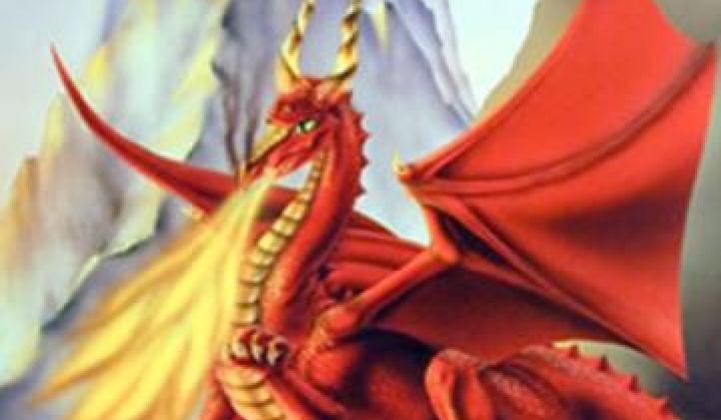In 2010, China took the wind capacity world lead. It installed three times as much wind as the U.S. and almost as much as the rest of the world combined. Morgan Stanley predicts China will build from its present 40,000-megawatt wind power capacity to 300,000 megawatts by 2020. That makes anything that happens in China's wind sector interesting and what American Superconductor (AMSC) has been, is and will be doing there especially interesting.
“AMSC started looking at China in the 2005 timeframe,” said AMSC Communications Director Jason Fredette. “We called it Project Dragon. The intent was to look for ways to serve the market locally and reduce our manufacturing costs by producing locally in China.”
The company had been selling its power electronic systems to wind turbine designer Windtec, which was packaging them with other power electronics and selling them to turbine manufacturers in China. Seeing a strategic opportunity, AMSC bought Windtec to gain direct access. “That cemented our entry,” Fredette said. “We set up operations right around the time of that closing in 2007.”
A key hire, Fredette said, was China VP/General Manager John Wang, who had a background in China’s hydropower and wind industries. From the beginning, Fredette said, Wang worked “hand-in-hand” with AMSC President Dan McGahn and CEO Greg Yurek. Wang continues, from AMSC China headquarters in Suzhou, to oversee AMSC operations at facilities in Beijing and Shanghai and at regional service centers throughout the country.
The key lesson AMSC has learned in China is that “it is a slightly different mentality,” Fredette said. “We Westerners always think about profit first,” but “policy dictates what happens in China. It’s a top-down approach.”
China leaders’ focus is economic development. “Power is absolutely fundamental to China’s continued growth,” Fredette explained. “Getting your head around that is very important as you approach the market.”
China’s power businesses do not “necessarily look at the bottom line for power generation, transmission and distribution.” Fredette explained. “Also, it’s what the country heads dictate, which is 'Make sure our power is strong, make sure our power reliability is strong, so our economy can continue to be strong.’ Without power,” Fredette said, “economies can’t grow.”
Understanding this about China has worked well for AMSC. Windtec’s revenues in 2006 were “about thirteen million dollars. We’re projecting AMSC’s total revenues this fiscal year will be $430 million to $440 million with about 80 percent from China’s wind industry. “AMSC,” Fredette said, “is a key enabler of China wind.”
Referring to Sinovel and Dongfang Electric, Fredette added that AMSC’s six Chinese wind industry customers include “two of the top three wind turbine manufacturers in China; actually, they're two of the top ten turbine manufacturers in the world.”
“Our main business in China today is licensing and co-developing wind turbines and selling power electronics and control systems,” Fredette said.
AMSC is also beginning to make headway with D-VAR, a tool “that helps to connect wind farms to the power grid,” Fredette said. “We have our first four customers in China and we see great potential,” as “they need to connect more and more of the wind supply to the grid without affecting the grid operator.”
Long term, AMSC sees even bigger potential for Amperium, its advanced superconductor wire. “State Grid,” he explained, controls 90 percent of China’s power transmission and “is looking to take on its first cable project right now involving superconductors.” American Superconductor hopes be involved. “Once that cable is in the ground, as is the case in virtually every other clean technology in China, we believe the superconductor market will develop quite rapidly.”
Superconducting material “can carry about a hundred times as much power as a conventional conductor like aluminum or copper.” Plus, “it’s inherently smart,” Fredette said. “You can only put so much copper cable under your streets.” Superconductor cable is the obvious solution as cities expand. “China is now moving on that path.”
AMSC’s strategy in these areas is constant. “We’re not trying to sell the end product in China. We’re not trying to be the primary OEM. We’re providing the fundamental technology or technologies that are utilized in these big clean technology products that domestic companies in China are producing.” Fredette called it an “Intel Inside model.”
It is hard, Fredette added, “to go head-to-head with Chinese brands and Chinese companies because, ultimately, they’re going to have a lower cost structure than a Western company and, over time, product quality is going to be equivalent if not better.” But, he said, “if you can provide value to those customers, and technology advances that they can utilize in their products, you can be a tremendous success.”
AMSC has found that “Chinese companies really do value Western technology,” Fredette said. By providing it, AMSC expects to be a part of China’s international pace-setting wind and transmission build out. “The vast majority of AMSC’s revenues are coming directly from China today,” Fredette said. “And we believe we will continue to grow our business aggressively there, not only on the wind side, but also increasingly in the power grid space.”
And, Fredette added, “our superconductor business, we think, is going to be the biggest growth driver for our company,” with “literally multi-billion dollar potential.”



